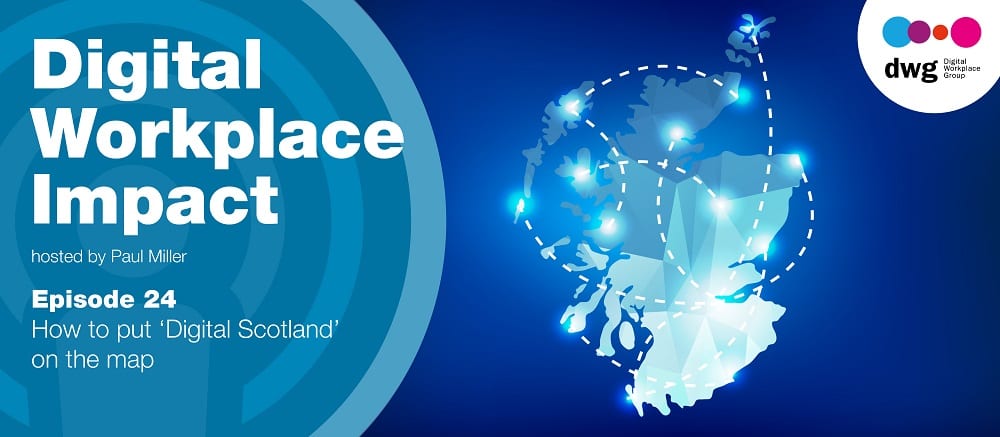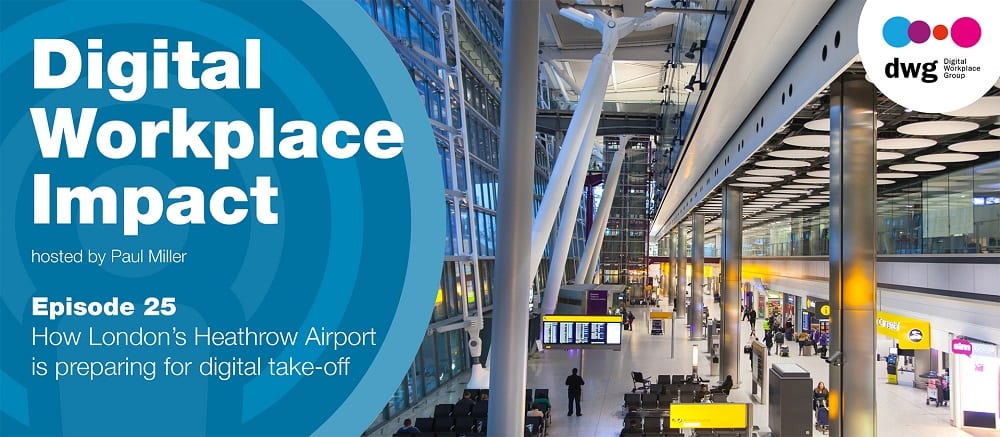Four digital workplace insights from the Digital Workplace Impact podcast
How do you achieve digital workplace success?
As many organizations are still evolving their approach to the digital workplace and digital transformation, it’s great to hear from early adopters, innovators, leaders and other players who are making headway in this space. In this way we can share experiences and collectively learn.
One of our goals in producing the Digital Workplace Impact podcast is to contribute to this shared learning by exploring fascinating digital themes with a variety of guests from different organizations across the world. What are their their successes, challenges and visions for the future? What is the impact of digital on employees, organizations and beyond? Digital Workplace Group (DWG)’s CEO and Founder Paul Miller has had many thought-provoking conversations with a broad range of guests. Here’s a round-up of four recent episodes that stood out for me in offering interesting insights into the digital workplace.

Episode 22: What makes Kansas City (and many other cities) so smart?
Key Takeaway: Moving forward with a digital programme requires joined-up and connected thinking between different stakeholders
In Episode 22, Paul Miller delved into the fascinating topic of smart cities with Bob Bennett, Chief Innovation Officer for Kansas City, and Gordon Feller, Founder of the Meeting of the Minds smart city program. Smart cities use data and technology to stay connected, improve services for citizens and make the cities better places to live. Of course, there are multiple ways in which to achieve this, including creating digital experiences for citizens so they can interact with services using their mobile phones, and using sensors to gather and then publish environmental data, which can also be used for planning purposes.
Kansas City is recognized as a smart city that has been getting even smarter. Not only is it unusual for a city to employ a Chief Innovation Officer, but the city has also introduced other interesting initiatives. When asked which achievement Bob Bennett is most proud of, he mentions an algorithm which tries to understand contributory factors for levels of crime in each of the city’s districts. The algorithm takes data from across all the city’s departments, including initiatives such as public health provision, and facilities or schemes that give young people things to do, in order to try and ascertain the factors that make the city a safer place in which to live.
Implementing an algorithm such as this requires joined-up and connected thinking from different stakeholders within the organization. A similarly ‘connected’ approach is needed with stakeholders across the city. In the podcast, Bennett and Feller reflect on the importance of partnerships between other digital providers, corporate employees, academic institutions, local politicians and community leaders, which all help to make smart cities work. It was also very interesting to hear how Bennett’s previous experiences in the US military had underlined the importance of working together behind a shared vision to rebuild the areas impacted by military action.
Although a different context to a smart city, many of the same approaches are critical to a successful digital workplace within one organization. Connected thinking between different stakeholders helps to create connected organizations.

Episode 24: How to put Digital Scotland on the map
Key Takeaway: The digital workplace is as much a cultural shift as a technological shift
Over the past few years, Scottish Government has continued to take a progressive view of using digital channels and experiences not only to improve work for employees but also to engage with Scottish citizens and improve public services. In Episode 24 of Digital Workplace Impact, we heard from Scottish Government’s Ken Goodlad about some of the initiatives that have been undertaken.
Goodlad’s view is that successful workplaces need to merge the digital, physical and cultural worlds. Scottish Government has been doing just that with the launch of an award-winning intranet that focuses on the wider digital workplace (“digital”), while also looking into the optimization of space to make it more collaborative (“physical”). On the cultural side, Goodlad and his team have been particularly active, with a series of change management activities and interventions, which are undoubtedly supporting Scottish Government’s wider digital ambitions.
In the podcast, it was very interesting to hear the detail behind Scottish Government’s “Digital Friends” mentoring programme, which pairs up senior civil servants with more digitally confident younger employees, not just to improve the digital confidence of those leaders but also to give the younger employees a fantastic networking opportunity. The programme has been so successful that it has now been extended to all levels of staff and original mentees are signing up to be mentors themselves – evidence of an “organic” shift in digital culture.
Giving support to senior management and staff to enable them to be more confident in using social media has also increased engagement with the public. As more Scottish Government employees start to “Work out Loud” and use digital channels to be open and get input from the public, “digital” is increasingly becoming part of the culture of government and the way things are done.
This episode of the podcast has lots of interesting detail about other initiatives as well, including CivTech and more. It’s worth a listen for anyone wanting to move towards a more digital culture in whatever arena.

Episode 25: How London’s Heathrow Airport is preparing for digital take-off
Key Takeaway: The importance of focusing on the before and after is key to digital workplace success
In Episode 25, we heard from Neil Barnett, Senior Digital Communications Manager at Heathrow Airport. Neil has been helping to lead Heathrow’s ambitious internal digital transformation programme, which has seen various initiatives such as the launch of a new mobile-first intranet, the deployment of Wi-Fi throughout the airport, new laptops and devices, the roll-out of Office 365 and more.
Heathrow Airport is a unique workplace in that it is almost like a city, even having its own police force and weather forcecaster! It also has a very diverse working population, including office staff, baggage handlers, engineers, security staff and even railway workers who work for the Heathrow Express train service. There are also thousands of people who are directly employed by the airlines and retail outlets rather than working directly for Heathrow. One of the central tenets of the programme has to been to deliver as many services as possible through mobile devices, which is critical for a workforce where only a minority of employees have a fixed desk.
A key insight when delivering a digital workplace programme that is truly focused on the needs of employees is the importance of user research and change management. Before designing the programme, the team at Heathrow carried out workshops, interviews and other user research to understand the pain points, device usage and opinions of a range of personas. Gaining a true understanding was critical to designing the right programme. Since implementation, the team has also spent a great deal of time explaining and promoting the programme, using champions to help embed the changes with employees through peer-to-peer sessions.
Neil explained that in digital transformation the implementation is usually the easy part. Focusing on the before (research and discovery) and the after (change management) is what makes all the difference to success.

Episode 27: How technology is ‘renovating’ the home of cricket
Key Takeaway: A mindset which sees beyond organizational boundaries to the wider community is an asset for moving forward with the digital workplace
English cricket and the world-famous Lord’s cricket ground aren’t perhaps what you would immediately associate with a digital “mindset” but actually the England and Wales Cricket Board (ECB) is supporting the national team, quietly advancing the digital workplace for employees and working hard to create digital experiences for everyone in the game right down to those involved in running cricket at the grassroots level.
In Episode 27, Paul talked to Damian Smith, Head of ICT at the ECB, about the range of digital projects the ECB is running, and it was fascinating to hear how the IT function supports everything from a Performance Analysis Centre, which takes a data-driven approach, to improving team performance and running the systems that support governance in the game, such as the anti-doping system.
What really stood out for me was Smith’s mindset, which refused to view the organization as a set of 250 employees, or even the thousands of staff involved in county and club cricket who rely on ECB technology and systems. Smith also wanted to impact those who run the game at a grassroots level across several thousand cricket clubs.
Here there are still many opportunities to modernize processes and make clubs easier to manage. This is key to getting in new people to run the clubs, which tend to be over-reliant on older volunteers. If the ECB can use digital to achieve this, it will help to attract more young people to play cricket and sustain the next generation of national players. This positive mindset, which goes beyond firewalls and views the benefits of engaging digitally with the wider community, will resonate strongly with all of us involved with managing and improving digital workplaces.
Subscribe to the Digital Workplace Impact podcast
There are many other fascinating episodes of Digital Workplace Impact to explore in Season One and Season Two. If you don’t want to miss an episode, why not subscribe? You can do so via iTunes, Stitcher Radio and SoundCloud. Happy listening!
RESEARCH AND RESOURCES
- FREE REPORT: Digital workplace integration: Key approaches to drive benefits
- FREE REPORT: Digital Workplace 2030
TAKE THE NEXT STEP
Categorised in: Digital workplace


